https://rumble.com/v1glsch-live-7pm-shocking-white-embalmer-clots-are-self-assembling-circuits.html
Wednesday, August 17, 2022 by: Mike Adams
În prezent, publicăm rezultatele testelor de laborator ICP-MS care compară compoziția elementară a sângelui uman cu compoziția elementară a unei mostre de cheag prelevate din corpul unei persoane care a fost vaccinată cu covidă și care a murit ulterior. Acest cheag a fost furnizat de îmbălsămătorul Richard Hirschman, iar acești cheaguri sunt raportate pe scară largă în corpurile persoanelor care au "murit brusc" în săptămânile sau lunile de după ce au primit unul sau mai multe vaccinuri covidiene.
Potrivit unei analize riguroase bazate pe date privind numărul excesiv de decese - rezumate frumos de Steve Kirsh de la Substack - în prezent, aproximativ 10.000 de persoane mor în fiecare zi din cauza vaccinurilor cu covidă. Probabil că până acum au avut loc în întreaga lume între 5 și 12 milioane de decese, iar în condițiile în care acești cheaguri care se autoasamblează continuă să capete dimensiuni și masă în interiorul corpurilor celor care au primit injecțiile cu medicamentul experimental mRNA, este sigur că multe persoane care nu au murit încă din cauza vaccinurilor vor cunoaște moartea în lunile și anii următori.
Kirsch a estimat aproximativ că, în prezent, o persoană moare la fiecare 1.000 de doze de vaccinuri covidiene care sunt administrate. Acest număr va crește aproape sigur cu timpul, deoarece cheagurile care provoacă atât de multe decese par să continue să "crească" (să se autoasambleze) în interiorul vaselor de sânge și arterelor victimelor vaccinurilor. Astfel, numărul final al victimelor vaccinurilor cu covidă va fi resimțit doar pe o perioadă de câțiva ani și ar putea fi cu câteva ordine de mărime mai mare, potențial de 1 la 100 sau chiar 1 la 10, deși va trebui să urmărim cu atenție excesul de decese în următorii ani pentru a ști unde se stabilizează acest fenomen de deces post-vaccinal.Până în prezent, au fost administrate peste 12 miliarde de doze de vaccin covidic în întreaga lume. Peste 600 de milioane de doze au fost administrate în Statele Unite, iar Kirsch estimează că 600.000 de americani au fost probabil deja uciși de vaccinurile covidiene numai în SUA. (Această cifră este de aproximativ 12 ori mai mare decât numărul total de victime ale soldaților americani în războiul din Vietnam, pentru comparație).
Iată o fotografie pe care am făcut-o cu unul dintre aceste cheaguri, la microscopul de laborator:Urmărind misterul cheagurilor post-vaccinale
Dr. Jane Ruby a fost unul dintre cercetătorii aflați în prima linie în încercarea de a determina compoziția acestor cheaguri, precum și mecanismul lor de acțiune în provocarea deceselor victimelor. Dr. Ruby ne-a pus în legătură cu Hirschman și ne-a ajutat să obținem probele de cheaguri pe care le-am testat prin ICP-MS în laboratorul nostru acreditat ISO și aprobat 17025, specializat în analiza alimentelor și a apei.
Ca o dezvăluire completă, laboratorul nostru este acreditat, auditat, inspectat și validat pentru testarea ICP-MS în probe de alimente și apă, precum și în alte domenii, cum ar fi analiza cuantificării canabinoidelor în probe de extract de cânepă. Cu toate acestea, domeniul de acreditare al laboratorului nostru nu cuprinde în mod specific probe biologice umane, deoarece nu oferim astfel de teste publicului. Cu toate acestea, testăm în mod obișnuit probe de hrană pentru câini și pisici, care sunt, desigur, compuse din carne de animal și vase de sânge măcinate, țesut de carne, cartilaj și alte structuri biologice de origine animală, și folosim exact aceleași metode de pregătire a probelor, de digestie, de analiză și de raportare pentru probele de cheaguri post-vaccinale. De asemenea, testăm în mod obișnuit probe de carne de vită, de pasăre, de pește și alte probe de carne. Astfel, suntem foarte încrezători în acuratețea acestor rezultate. În plus, nu am observat niciun eșec în timpul procesului de pregătire a probelor. Întregul cheag a fost dizolvat în acid azotic, ceea ce înseamnă că elementele sale au intrat în soluție și au putut fi analizate prin ICP-MS.
Aceste teste ICP-MS au fost efectuate la 23 iunie anul acesta. Am întârziat publicarea rezultatelor pentru a avea timp să împărtășim aceste cifre cu colegii și pentru a solicita feedback din partea altora. Aceste PDF-uri au fost, de asemenea, împărtășite în privat cu Dr. Jane Ruby și cu alte persoane. Nimeni cu expertiză în acest domeniu nu a semnalat probleme sau îngrijorări aparente cu privire la această analiză. În orice caz, analiza ICP-MS este destul de simplă: Probele sunt "digerate" în acid azotic, acest acid este nebulizat într-un flux lichid care trece printr-o torță cu plasmă, este ionizat și apoi dirijat printr-un ansamblu de cuadripol care sortează elementele în funcție de raportul masă-încărcare. Fiecare element individual este scanat și numărat pe un PMT (tub foto-multiplicator) care transformă elementele individuale în curent electric care poate fi numărat cu precizie. Aceste rezultate sunt comparate cu standardele externe care sunt trasabile NIST pentru a furniza curbe de calibrare foarte precise, ceea ce înseamnă că datele de cuantificare sunt extrem de fiabile.Rezultatele analizei ICP-MS arată că acești cheaguri nu sunt făcuți din sânge - nu sunt "cheaguri de sânge"
Deși intenționăm să efectuăm mai multe teste pe cheaguri și pe probe de sânge, datele pe care le vedem până acum arată clar că acești cheaguri nu sunt "cheaguri de sânge". Ei nu sunt pur și simplu făcuți din sânge închegat.
De unde știm acest lucru? Pentru că raporturile și densitățile elementelor sunt foarte diferite. Luați în considerare următoarea diagramă comparativă, bazată pe rezultatele noastre ICP-MS (a se vedea rezultatele complete de mai jos), și observați diferențele flagrante dintre concentrațiile elementare din sânge față de cheaguri în rândul elementelor nutritive "marker", cum ar fi fierul și magneziul:
Element Rezultatele din sânge Rezultatele din cheag
Mg (magneziu) 35 ppm 1,7 ppm
K (potasiu) 1893 ppm 12,5 ppm
Fe (fier) 462 ppm 20,6 ppm
Zn (zinc) 7,9 ppm 2,4 ppm
Cl (clor) 930,000 ppm 290,000 ppm
P (fosfor) 1130 ppm 4900 ppm
După cum puteți vedea, proba de cheag post-vaccin conține doar 4,4% din fierul care ar fi observat în sângele uman. Numai acest lucru este o confirmare că acest cheag nu este un "cheag de sânge". În plus, observați lipsa aproape totală a potasiului (K) în proba de cheag. Cheagul conține mai puțin de 0,6% din potasiu ca sângele uman. Este o poveste similară și cu magneziul.Mai multe elemente conductoare de electricitate au fost mai mari în cheag.
În plus față de elementele nutritive prezentate mai sus, am observat un tipar deosebit în rândul elementelor conductoare de electricitate, cum ar fi sodiul (Na), aluminiul (Al) și staniul (Sn). Pentru tabelul următor, vă rugăm să rețineți că rezultatele privind staniul și sodiul provin dintr-un raport "semicantitativ" separat, care este mai puțin precis decât analiza "fullquant" utilizată pentru toate celelalte elemente prezentate aici. În esență, cifrele semi-cantice sunt precise în ceea ce privește concentrațiile relative de la o probă la alta, dar nu sunt comparate cu probe externe calibrate, astfel încât concentrația reală (absolută) raportată nu are intervalul de încredere al rezultatelor fullquant:
Element Rezultate la sânge Rezultate la cheaguri Rezultate la cheaguri
Na (sodiu) 1 050 ppm* 1 500 ppm* 1 500 ppm*
Sn (staniu) 163 ppm* 942 ppm* 942 ppm*
Al (aluminiu) 1,3 ppm 1,6 ppm
* = rezultate SemiQuant, nu FullQuant
Având în vedere că sodiul este cu aproape 50% mai mare în cheag, iar staniul prezintă o creștere de 588%, nu putem concluziona decât că cheagul care se autoasamblează "recoltează" sau concentrează anumite elemente din sângele care circulă în timp ce are loc asamblarea cheagului. Este demn de remarcat faptul că multe dintre aceste elemente sunt conductoare. Aluminiul, de exemplu, este cea mai comună alternativă la cupru pentru utilizarea în cablurile electrice. Sodiul este un metal alcalin foarte conductiv, iar staniul este utilizat ca element principal în aliajele de lipit folosite pentru fabricarea sau repararea plăcilor de circuite.
Puteți vedea cifrele privind conductivitatea elementară în acest tabel de referință privind conductivitatea electrică de la Angstrom Sciences.
O concluzie este inevitabilă: Cheagul este aproape în întregime lipsit de elemente marker cheie care ar fi prezente în sângele uman (cum ar fi fierul și potasiul), dar prezintă concentrații semnificativ mai mari de elemente care sunt utilizate în electronică și circuite.
Îl invităm pe cititor să tragă propria concluzie cu privire la explicația din spatele acestui fapt, menționând doar că brevetele doctorului Charles Lieber pot prezenta un interes deosebit.
Această analiză, în special, nu răspunde la nicio întrebare dacă acești cheaguri sunt "vii" sau morți (ca părul și unghiile). Propria mea opinie profesională este că acești cheaguri nu sunt structuri vii. Ei par a fi biostructuri moarte care se autoasamblează, din ceea ce putem vedea până acum. Dar aceasta este doar o evaluare inițială și se poate schimba odată cu observații sau constatări suplimentare. Prionii, de exemplu, sunt și ei biostructuri care se autoasamblează, dar care nu sunt vii. În esență, ei sunt proteine prost pliate care se răspândesc în tot creierul (sau în alte regiuni), provocând modificări morfologice care anulează atât structura, cât și funcția normală a celulelor neurologice. Nu este necesar ca ceva să fie viu pentru a se autoasambla. Chiar și virușii, așa cum sunt descriși de virusologia tradițională, sunt structuri moarte care, cu toate acestea, se autoasamblează și pot "crește" în dimensiune și masă în ceea ce privește populația lor agregată.
Următoarea imagine microscopică, realizată în laboratorul nostru la o mărire de aproximativ 1.500 x, arată ceea ce pare a fi o structură repetitivă pe o proeminență cu aspect de sârmă din unul dintre aceste cheaguri. În cazul în care vă întrebați, nu este un fir de păr uman. Este conectat la cheagul.
You can also download the full PDF document for the blood analysis here.
EXCLUSIVE: Natural News releases post-vaccine clot ICP-MS elemental analysis results, comparing clots to human blood … findings reveal these clots are NOT “blood” clots
Wednesday, August 17, 2022 by: Mike Adams
Tags: badhealth, badmedicine, Blood clots, COVID, goodscience, ICP-MS, lab tests, outbreak, pandemic, Vaccine deaths, vaccine injury, vaccines
This article may contain statements that reflect the opinion of the author
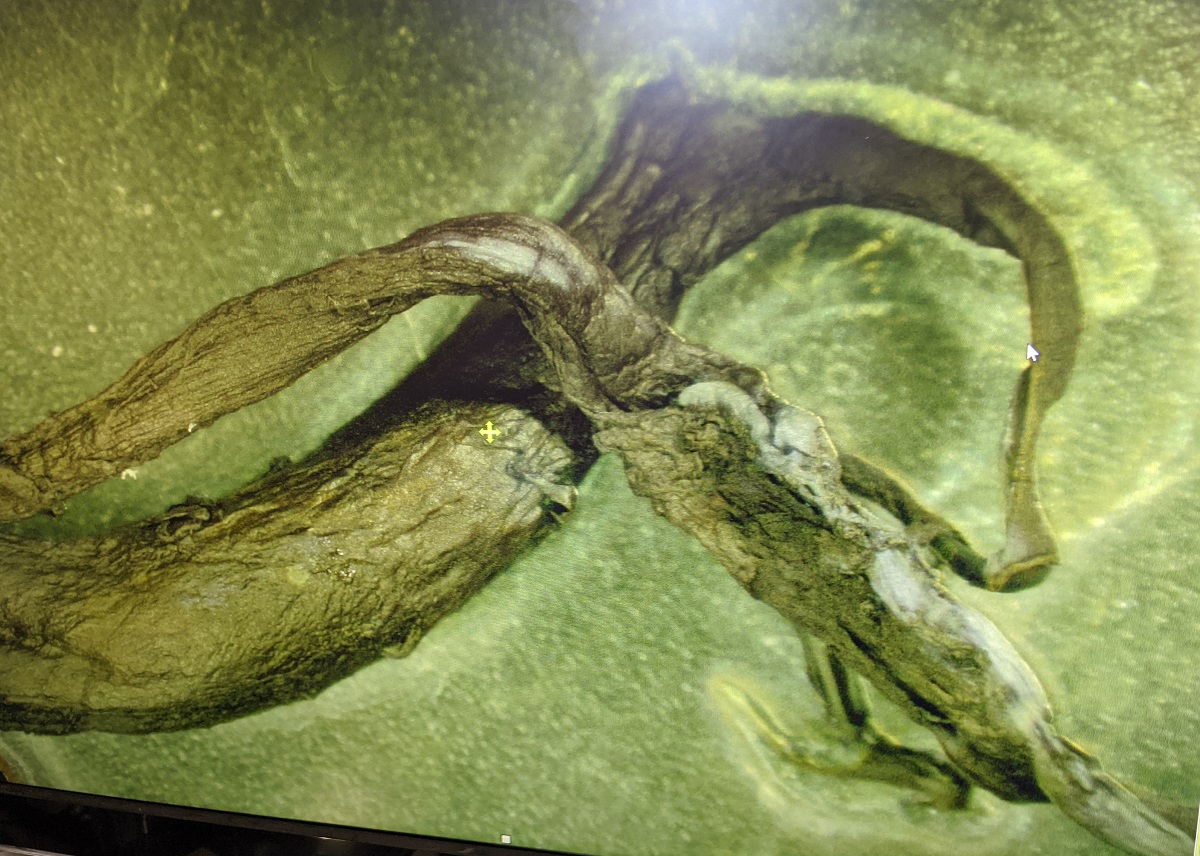
(Natural News) We are now releasing ICP-MS lab test results that compare the elemental composition of human blood to the elemental composition of a clot sample taken from the body of a person who received a covid vaccination and then subsequently died. This clot was provided by embalmer Richard Hirschman, and these clots are being widely reported in the bodies of people who have “died suddenly” in the weeks or months after receiving one or more covid vaccinations.
According to rigorous analysis based on excess death data — summarized nicely by Steve Kirsh at Substack — there are currently around 10,000 people dying each day from covid vaccines. Anywhere from 5 to 12 million fatalities have likely occurred worldwide so far, and with these self-assembling clots continuing to gain size and mass inside the bodies of those who have received the mRNA experimental medicine injections, it is certain that many people who have not yet died from the vaccines will experience death in the coming months and years.
Kirsch has roughly estimated that 1 person is currently dead for every 1,000 doses of covid vaccines that are administered. This number will almost certainly increase with time, as the clots that are causing so much death appear to be continuing to “grow” (self-assemble) inside the blood vessels and arteries of vaccine victims. Thus, the final toll of covid vaccines will only be experienced over a period of several years and could be orders of magnitude higher, potentially 1 in 100 or even 1 in 10, although we will have to watch excess deaths carefully over the next several years to know where this post-vaccine death phenomenon levels out.

So far, over 12 billion covid vaccine doses have been administered worldwide. Over 600 million doses have been administered in the United States, and Kirsch estimates that 600,000 Americans have likely already been killed by covid vaccines in the USA alone. (That’s about 12 times higher than the total casualties of US soldiers in the Vietnam War, for comparison.)
Here’s a photo that I took of one of these clots, under a lab microscope:
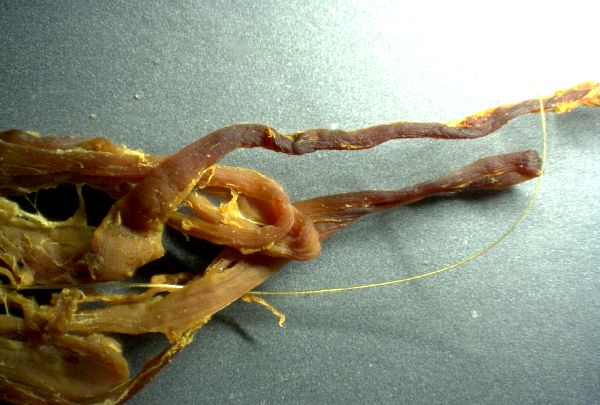
Pursuing the mystery of the post-vaccine clots
Dr. Jane Ruby has been one of the researchers at the forefront of attempting to determine the composition of these clots as well as their mechanism of action in causing fatalities in victims. Dr. Ruby connected us with Hirschman and helped arrange for the clot samples which we have tested via ICP-MS in our ISO-accredited, 17025 approved laboratory which specializes in food and water analysis.
In full disclosure, our laboratory is accredited, audited, inspected and validated for ICP-MS testing in food and water samples, as well as other areas such as cannabinoid quantitation analysis in hemp extract samples. However, the accreditation scope of our lab does not specifically encompass human biological samples, as we do not offer such testing to the public. Nevertheless, we routinely test dog food and cat food samples which are, of course, composed of animal flesh and ground blood vessels, meat tissue, cartilage and other animal-derived biological structures, and we are using the exact same sample preparation, digestion, analysis and reporting methods for post-vaccine clot samples. We also routinely test beef, poultry, fish and other meat samples. Thus, we are highly confident in the accuracy of these results. Furthermore, we did not see any failures during the sample prep process. The entire clot was dissolved in nitric acid, meaning its elements went into solution and were able to be analyzed via ICP-MS.
Here’s a photo of some of the clots found in the body of the deceased:
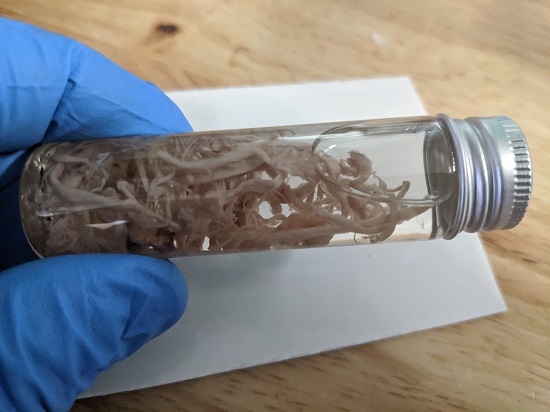
These ICP-MS tests were conducted on June 23 of this year. We have delayed public release of the results in order to allow time to share these numbers with colleagues and to invite feedback from others. These PDFs have also been shared privately with Dr. Jane Ruby and others. No one with expertise in this field has indicated any apparent problems or concerns about this analysis. If anything, the ICP-MS analysis is rather straightforward: Samples are “digested” into nitric acid, this acid is nebulized into a liquid stream which goes through a plasma torch, gets ionized and then directed through a quadrupole assembly that sorts the elements by their mass-to-charge ratios. Each individual element is scanned and counted on a PMT (Photo Multiplier Tube) which translates individual elements into electrical current that can be accurately counted. These results are mapped against external standards which are NIST traceable to provide very accurate calibration curves, which means the quantitation data are extremely reliable.
We used 0.4528 grams of the clot as the sample mass in this case:
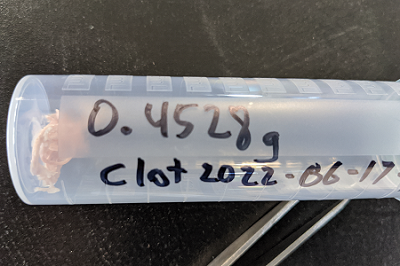
For a primer on ICP-MS and why it is so accurate, see this NIH article.
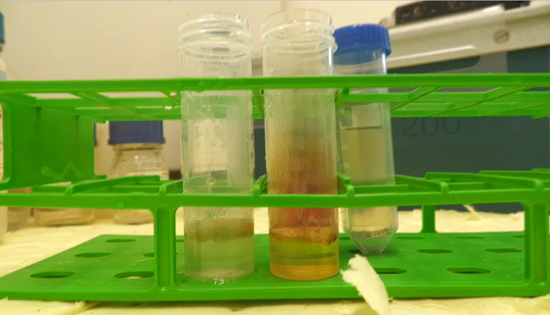
ICP-MS analysis results reveal that these clots are not made of blood – they are not “blood clots”
Although we intend to conduct more tests on clots and blood samples, the data we see so far make it clear that these clots are not “blood clots.” They are not simply made of congealed blood.
How do we know this? Because the elemental ratios and densities are vastly different. Consider the following comparison chart, based on our ICP-MS results (see full results below), and notice the stark differences between the elemental concentrations in blood vs. clot among nutritive “marker” elements such as iron and magnesium:
| Element | Blood Results | Clot Results |
| Mg (magnesium) | 35 ppm | 1.7 ppm |
| K (potassium) | 1893 ppm | 12.5 ppm |
| Fe (iron) | 462 ppm | 20.6 ppm |
| Zn (zinc) | 7.9 ppm | 2.4 ppm |
| Cl (chlorine) | 930,000 ppm | 290,000 ppm |
| P (phosphorous) | 1130 ppm | 4900 ppm |
As you can see, the post-vaccine clot sample only contains 4.4% of the iron that would be seen in human blood. This alone is confirmation that this clots is not a “blood clot.” In addition, note the near-total lack of potassium (K) in the clot sample. The clot contains less than 0.6% of the potassium as human blood. It’s a similar story with magnesium, too.
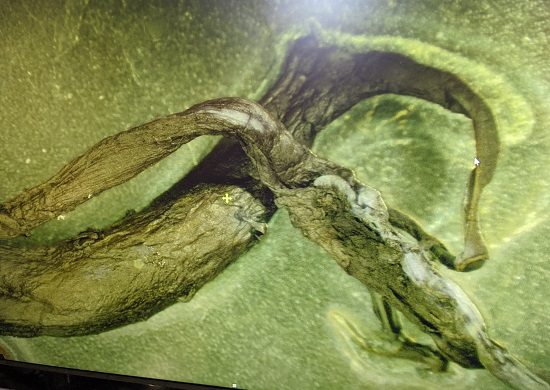
Several electrically conductive elements were higher in the clot
In addition to the nutritive elements shown above, we noticed a peculiar pattern among electrically conductive elements such as sodium (Na), aluminum (Al) and tin (Sn). For the following table, please note that the tin and sodium results come from a separate “semiquant” report which is less accurate than the “fullquant” analysis used for all the other elements shown here. In essence, the semiquant numbers are accurate in terms of relative concentrations from one sample to the next, but they are not compared to calibrated external samples, so the actual (absolute) concentration reported does not have the confidence interval of the fullquant results:
| Element | Blood Results | Clot Results |
| Na (sodium) | 1050 ppm* | 1500 ppm* |
| Sn (tin) | 163 ppb* | 942 ppb* |
| Al (aluminum) | 1.3 ppm | 1.6 ppm |
* = SemiQuant results, not FullQuant
With sodium being nearly 50% higher in the clot, and tin showing an increase of 588%, we can only conclude that the self-assembling clot is, in effect, “harvesting” or concentrating certain elements from circulating blood as clot assembly is taking place. It is noteworthy that many of these elements are conductive. Aluminum, for example, is the most common alternative to copper for use in electrical wiring. Sodium is an alkali metal that is highly conductive, and tin is used as the primary component in solder alloys used to manufacture or repair circuit boards.
You can see the numbers on elemental conductivity at this electrical conductivity reference table from Angstrom Sciences.
One conclusion is inescapable: The clot is almost entirely lacking key marker elements that would be present in human blood (such as iron and potassium) yet shows significantly higher concentrations of elements that are used in electronics and circuitry.
We invite the reader to draw your own conclusion of the explanation behind that, merely noting that the patents of Dr. Charles Lieber may be of special interest.
This analysis, notably, does not answer any question of whether these clots are “alive” or dead (like hair and nails). My own professional opinion is that these clots are not living structures. They appear to be self-assembling dead biostructures, from what we can see so far. But that’s just an initial assessment and may change with additional observations or findings. Prions, for example, are self-assembling but non-living biostructures too. They are essentially mis-folded proteins that spread throughout the brain (or other regions), causing morphological alterations that nullify both the normal structure and function of neurological cells. Something does not have to be alive in order to be self-assembling. Even viruses, as described by traditional virology, are dead structures which are nevertheless self-assembling and can “grow” in size and mass in terms of their aggregate population.
The following microscopy picture, taken at our lab at around 1500 x magnification, shows what appears to be a repeating structure on a wire-looking protrusion from one of these clots. In case you were wondering, is not a human hair. It is connected to the clot:
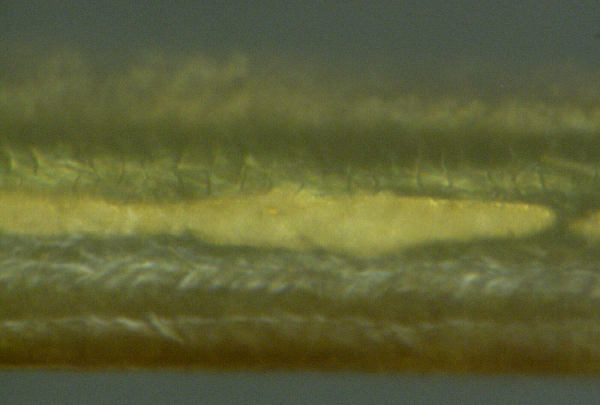
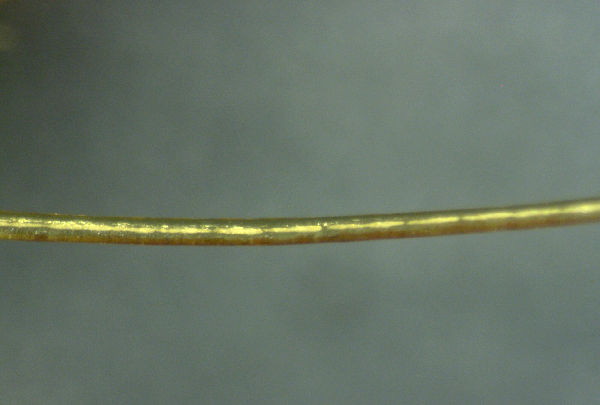
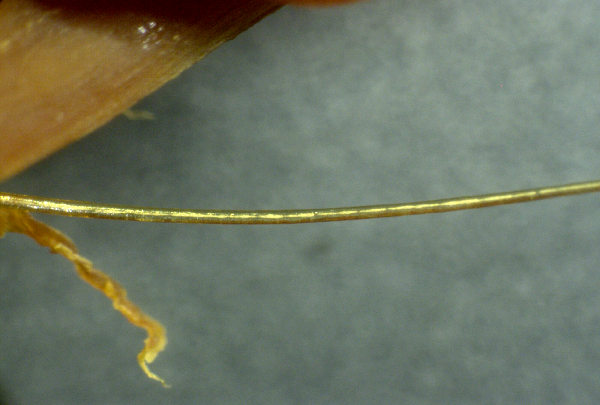
See the ICP-MS results for yourself
For those not familiar with the units being reported here:
ppb = parts per billion
ppm = parts per million
1,000 ppb = 1 ppm (because the metric system)
The units used by the instrument are mass over volume (m/v) and the “mass” is technically mass-to-charge ratio (m/z).
Here’s a screen shot of a section from the PDF report of the ICP-MS results for live human blood:
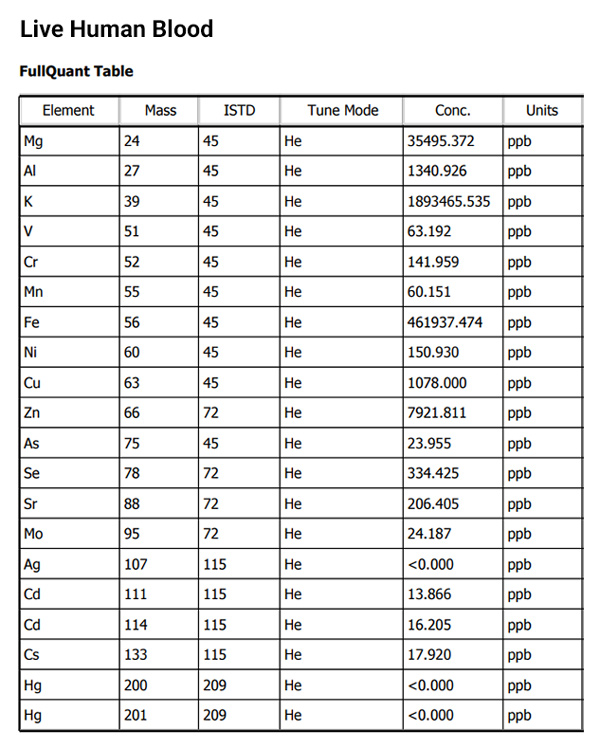
You can also download the full PDF document for the blood analysis here.
And here’s the screen shot of the results from the clot analysis, showing ICP-MS analysis for the post-vaccine clot:
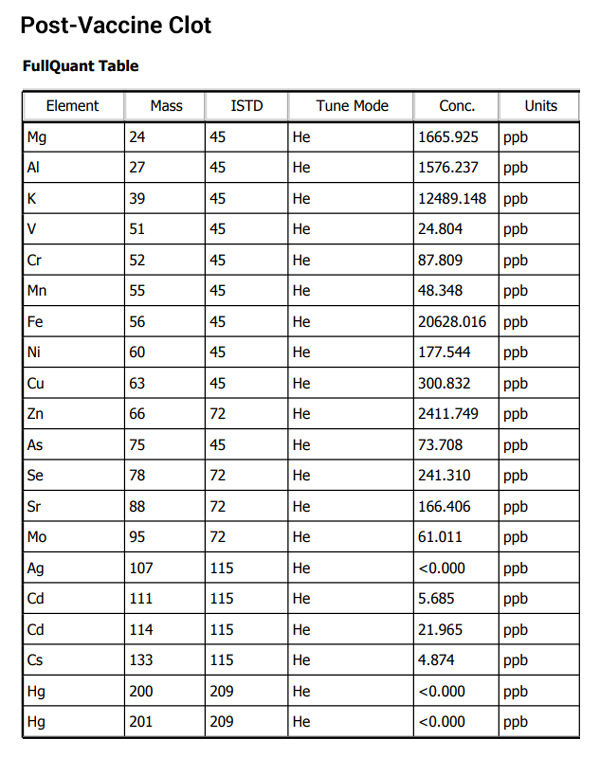
Finally, you can download the full PDF document of the ICP-MS analysis for the clot here.
Proteina Spike din COVID e forța motrice din spatele cancerului
Cole a explicat modul în care vaccinurile compromit sistemul imunitar în timpul unui interviu din 2022 cu Veronika Kyrylenko de la New American. El a reiterat faptul că proteina spike SARS-CoV-2 utilizată în injecție atacă receptorii din celulele umane care identifică celulele sănătoase de cele care provoacă boli.
Potrivit medicului din Idaho, el a văzut inițial leziuni virale ale pielii - întâlnite în mod obișnuit la copii - care se dezvoltau la pacienții săi adulți. În urma mai multor biopsii, el a observat o tendință de creștere a cancerelor feminine, inclusiv a celor de endometru și de col uterin, în rândul persoanelor în vârstă.
"După ce am raportat aceste cazuri, am avut tone de oncologi care au venit și au spus: "Da, văd că cancerele ciudate - [cele] pe care am reușit să le ținem sub control și să le tratăm - iau amploare ca un foc"", a declarat el pentru Kyrylenko. "Asta din cauza dereglementării imunitare pe care o provoacă aceste injecții".
Cole a subliniat că vaccinurile COVID-19 dezactivează unii dintre receptorii de tip Toll-like (TLR) din celulele umane, compromițând mecanismul de alertă al sistemului imunitar. Receptorii dezactivați includ TLR7 și TLR8, care detectează virușii, și TLR3 și TLR4, care țin sub control cancerul.
Proteina spike se leagă, de asemenea, de diferite gene, inclusiv de gena P53, care suprimă tumorile, de gena TMPRSS-2, legată de cancerul de prostată, și de genele BRCA, legate de cancerul de sân la femei.
"Facem o injecție care produce o proteină spike. Aceasta este o toxină care declanșează genele cancerului în moduri negative și dezactivează alți receptori de tip", a spus Cole. "[Aceasta] provoacă aceeași boală ca și virusul și predispune oamenii la atacuri autoimune și la riscuri potențiale de cancer pe termen scurt."
"Nu știm cât timp este suprimat sistemul imunitar după aceste injecții și cât timp sunt opriți acești receptori - pentru că aceste studii nu sunt făcute", a conchis el.
Mergeți la VaccineDamage.news pentru mai multe informații despre modul în care vaccinurile COVID-19 provoacă cancer.
Urmăriți mai jos interviul Dr. Ryan Cole cu Veronika Kyrylenko, în care acesta discută despre modul în care vaccinurile COVID-19 afectează sistemul imunitar.
https://www.brighteon.com/embed/898419ab-e36f-43a5-8700-e0e35b126273

Niciun comentariu:
Trimiteți un comentariu
Rețineți: Numai membrii acestui blog pot posta comentarii.